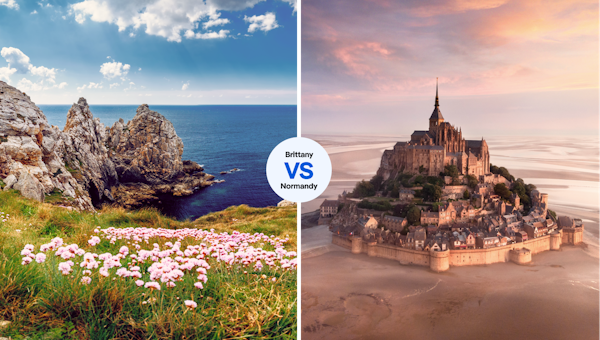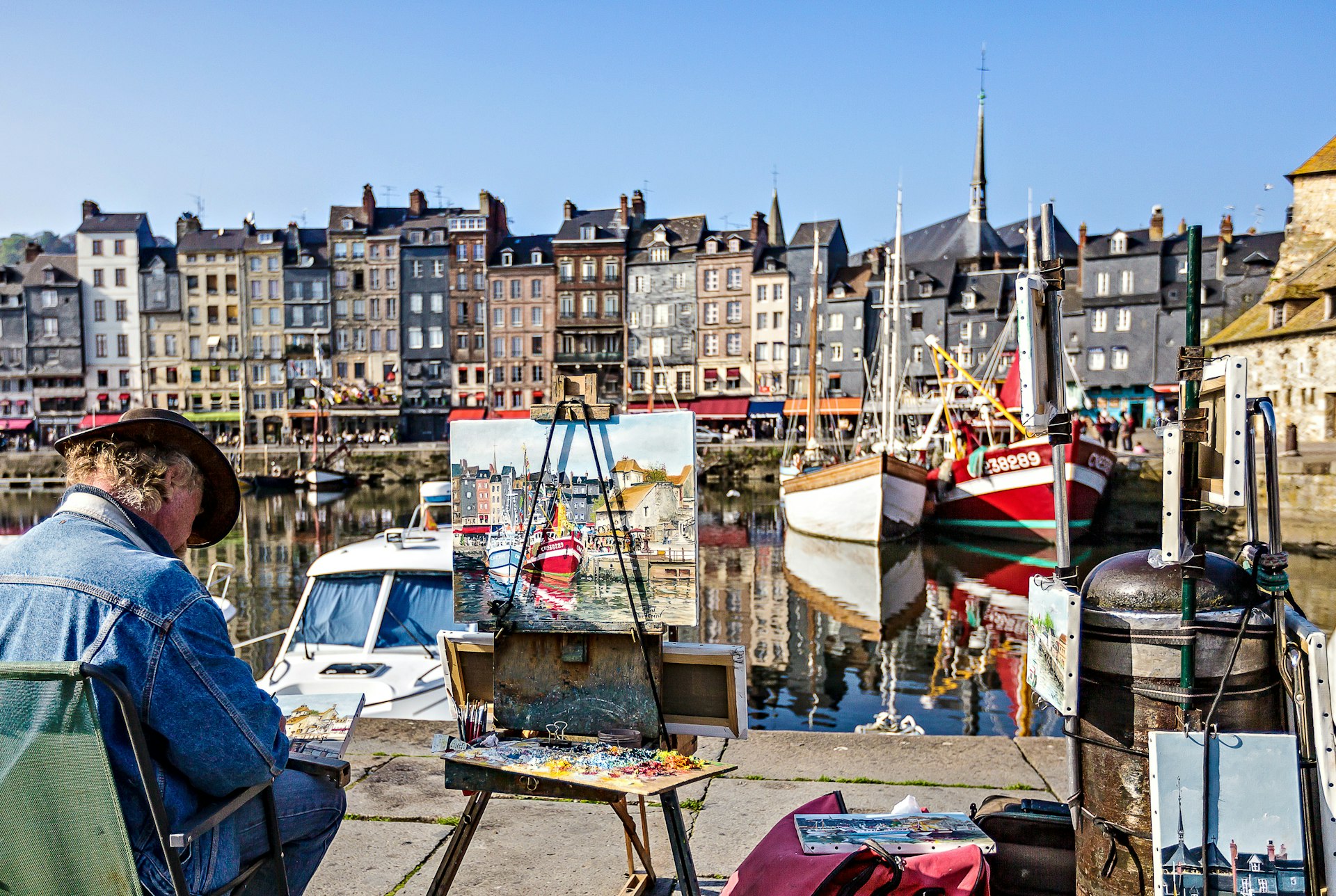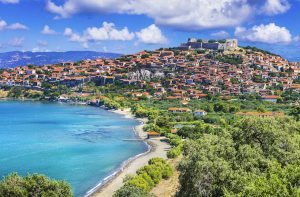
You can’t go wrong wherever you go in France, understandably the most visited country in the world. Yet if you’re homing in on the northwest part of this magical land, you might have a tough call to make.
Both with millennia of history, extraordinary culture and hundreds of miles of shore, Brittany and Normandy tempt in equal measure. But which region should get the nod? After reading these two extremely partisan takes, you decide.
Get local insight on destinations all over the world with our weekly newsletter delivered to your inbox.
Brittany? Bien sûr
Daphné Leprince-Ringuet is a writer and journalist based in France. She grew up between Paris and Brittany and considers herself Bretonne at heart – much to the despair of her truly born-and-raised Breton friends.
Let’s be honest: for most people planning a visit to France, Brittany is not an obvious go-to. Even the French usually need a bit of convincing before setting foot in the country’s westernmost region, often put off by the flawed assumption that summer days will be spent watching cold rain fall from a perpetually gray sky. Mostly seen as a bleaker version of Normandy – only without the high life and further from Paris – Brittany has a bad rep that stubbornly lives on.
But this is also potentially what gives the region one of its greatest strengths. Forget about Deauville’s and Trouville’s overcrowded beaches and extortionate deck-chair-rental fees. Imagine a summer that doesn’t require packing for fancy social occasions. At the risk of divulging a closely kept secret, let me reveal that Brittany is one of the last regions in France where you can sit on a sandy beach in the middle of July, facing a plastic-free, Caribbean-like sea with no other soul in sight. And guess what? The weather can actually be pretty good, too.
 In between dramatic cliffs, there is no shortage of appealing beaches in Brittany © Sameer Al-Doumy / AFP via Getty Images
In between dramatic cliffs, there is no shortage of appealing beaches in Brittany © Sameer Al-Doumy / AFP via Getty Images
A craggy, unspoiled coast
You won’t have to work hard to find your perfect spot, either; a quick search for images of the “Brittany coast” will convince you that there is no shortage of natural beauty here. From the Côtes d’Armor to the shores of Belle-Île en Mer through the Pointe du Raz, Crozon and the Quiberon peninsula, you will find yourself continually marveling at the quintessentially Breton contrast of quiet, inviting beaches suddenly giving way to weathered cliffs that dramatically tumble into the ocean. Even if the weather can be unreliable at times, it’s well worth pulling out a raincoat when the sky turns stormy to watch the spectacle of towering waves crashing into a coast, battered by furious, whistling winds.
Don’t worry: you also get to enjoy some simpler pleasures in Brittany. A gastronome will find only joy in a region where butter practically holds its own spot in the list of regional delicacies, and where ordering multiple mains in a crêperie is nothing out of the ordinary. If you have a healthy appetite, a slice of kouign-amann – which essentially consists of lots of butter, lots of sugar and a dash of flour – should also hit the spot. And as a rule of thumb, never miss a chance for an extra dose of salted butter caramel.
The region doesn’t disappoint on the savory side, either. Brittany stands at the intersection of land and sea, and you can expect to see this on your plate, with most menus featuring fresh fish and seafood next to locally sourced cuts of meat. Adventurous eaters will enjoy Guéméné andouille, Molène sausages and even seaweed-based dishes.
 Locals celebrate traditional Breton culture in medieval towns all over Brittany © Andia / Universal Images Group via Getty Images
Locals celebrate traditional Breton culture in medieval towns all over Brittany © Andia / Universal Images Group via Getty Images
Centuries of Celtic culture
Refreshingly, Brittany does its own thing and doesn’t try too hard to please – yet often does all the same. Pride in Breton identity is omnipresent, and there is no better setting to celebrate this than the region’s countless medieval towns, where you will find year-round tributes to Celtic history, legend and folklore. No matter when or where you visit, the chances are you will stumble upon a traditional Breton music concert or a Fest Noz dancing festival, reminding you that Brittany, often referred to as the “land of legends,” truly is a place where myth and reality collide.
Of course, you could simply jump on a high-speed train and reach Normandy’s beaches in a couple of hours. Chances are you wouldn’t feel too far from home – Parisians and foreign tourists alike flock to the region the moment sunshine makes an appearance in the weather forecast. But if you are after a unique adventure and some exhilarating sights, risk the rain, settle in for the journey and make your way to the place where the land ends.
Normandy can have Mont St-Michel. Brittany has all the rest.
 Picturesque Norman towns like Honfleur have inspired artists for centuries © Hippo1947 / Shutterstock
Picturesque Norman towns like Honfleur have inspired artists for centuries © Hippo1947 / Shutterstock
Normandy: bigger, better and with more cheese
Cyrena Lee is a writer based in Chailly-en-Bière and escapes to Normandy wherever she can for cold plunges on the sprawling beaches, sips of illegal calvados and the best crêpes in the world.
Normandy’s popularity dates back millennia: the sprawling sandy shores and abundant lush lands of northwestern France have been fought over for centuries on end. The Vikings invaded in the 9th century, battling the Bretons. William the Conqueror claimed Normandy – in Bayeux, you can see the astonishing medieval tapestry that tells his epic tale – before the king of France reclaimed the province in 1204, with the Bretons’ support.
A journey through Normandy is an immersive history lesson. World War II buffs can visit countless memorials in Caen, relive the nighttime D-Day landings of Operation Neptune at the Airborne Museum and contemplate the human toll of it all at the American Cemetery at Colleville-sur-Mer. The region is also replete with cathedrals, fortresses and castles fit for royalty. It’s also home to the last royal estate in France, Château d’Eu,
And then there’s the mythic, seemingly floating abbey of Mont-St-Michel, which symbolically sits between Normandy and Brittany and has been a contention point of rivalry practically since its construction. (Let’s be clear: it lies in Normandy.)
An inspiration for artists and artisans
Centuries-old squabbles aside, let’s turn to modern-day concerns. While Brittany may have kept the flames of its Celtic traditions alive, Normandy’s vast lands are full of contemporary trailblazers: artists, artisans and farmers who are creating a rich and modern culture.
The fruits of their labor are one-of-a-kind delights. Artists like Mathilde are making hand-crafted bags upcycled from oyster nets. The artisanal savoir-faire is evident in the handmade leather bags by Maroquinerie du Cotentin. And the annual PALMA Festival lets street artists take over the walls and musicians over the streets of Caen and Mondeville.
To name-drop just a bit, Normandy has been inspiring artists for centuries. Picturesque port city Honfleur was home to painter Eugene Boudin. Impressionist Claude Monet created his own fantasy garden at Giverny, where you can gaze at the water lilies yourself to this day. Even Vincent van Gogh painted in Normandy, making Auvers-sur-Oise the subject of one of his last works, Wheatfield with Crows. You can visit Gustave Flaubert’s Rouen, short-story writer Guy de Maupassant’s house in Étretat and Proust’s hotel in Cabourg (where he scribbled pages of his masterpiece In Search of Lost Time). And guess where Nobel Prize winning author Annie Ernaux comes from? Yep, Normandy. Hollywood stars also flock to glamorous beach town Deauville annually for the American Film Festival.
 Normandy produces four protected-origin cheeses, including irresistible Camembert © Charly Triballeau / AFP via Getty Images
Normandy produces four protected-origin cheeses, including irresistible Camembert © Charly Triballeau / AFP via Getty Images
Dazzling landscapes, and a cornucopia of culinary delights
Once you start taking in the views here, from the jaw-dropping cliffs at Étretat to the dunes of Cabrough, it comes as no surprise that the landscapes of Normandy have inspired so many artists. For the athletically driven, “Norman Switzerland” offers deep valleys and cliffside hikes, along with rock climbing, hang gliding and kayaking. Only in Clécy can you venture by via ferrata over the Orne River to an adrenaline-pumping, breath-taking zip-line finish.
Covering Normandy’s vast square mileage can be exhausting – so it’s lucky there’s something delicious to refuel with in nearly every corner. Sure, Brittany may have buckwheat crêpes and Europe’s richest pastry, the decadent kouign-amann, but Normandy offers a larger variety of culinary pleasures. A lighter and more unique dessert is la teurgoule, a rice pudding sweetened with cinnamon that’s beloved by Norman families. And the classic French apple tart hails from the region.
On the subject of ciders: there are a few exceptional ones from Brittany, yes – but Normandy offers a cider route over 25 miles long. Then there’s calvados, a head-spinning, AOP-protected apple brandy that can only be found in, well, Calvados. Normandy also produces pommeau, a delightful aperitif that artfully blends cider juice and calvados to appealing perfection. Normandy holds its own on the andouille front, too, with the local Vire sausage offering a subtle smokiness that beats out the fatty Breton Guémené.
Since the French like to finish their meals with cheese, this debate between Normandy and Brittany will end on the same note. Brittany produces a few kinds of yummy cheese, yes – but exactly zero bear the coveted AOP label. In Normandy, there are four protected-origin cheeses: world-famous Camembert, as well as the superb Livarot, Neufchatel and Pont-l’Évêque varieties
It’s safe to say that in a competition with Brittany, Normandy comes out the proverbial big cheese.



